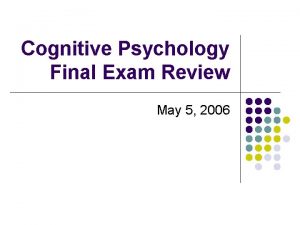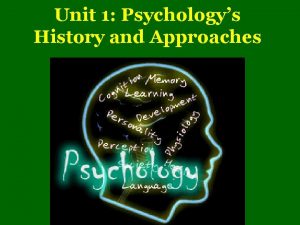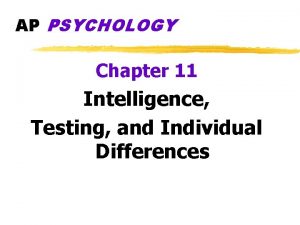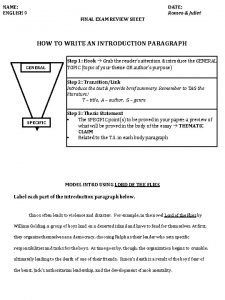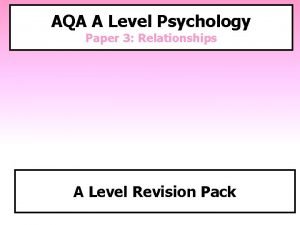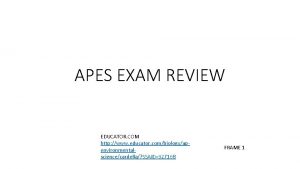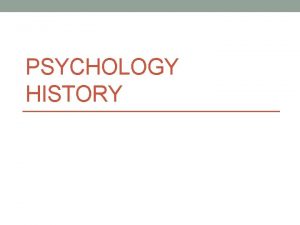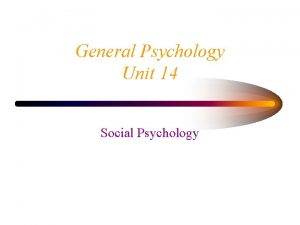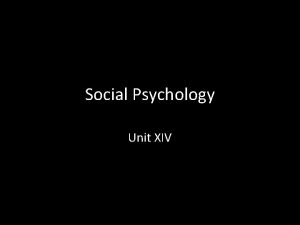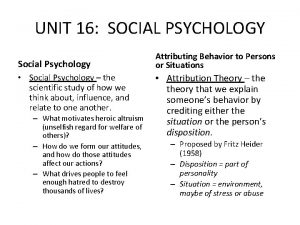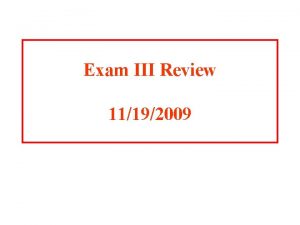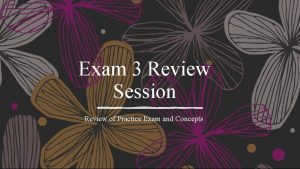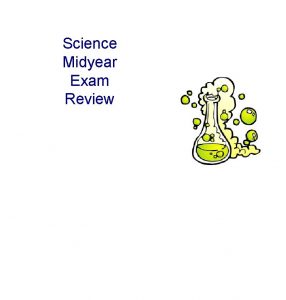Psychology AP Exam Review Unit 1 History and


































- Slides: 34

Psychology AP Exam Review Unit 1: History and Approaches Unit 2: Research Methods Unit 14: Social Psychology

Unit 1 Top Ten List (2 -4%) 1. 2. 3. 4. 5. 6. 7. 8. 9. 10. Philosophical perspectives’ influence on Psychological Thought Historical Approaches Biological Approach Behavioral Approach Cognitive Approach Humanistic Approach Psychodynamic Approach Sociocultural Approach Evolutionary Approach Different domains of Psychology

1. Philosophical perspectives’ influence on Psychological Thought Hippocrates, Plato Mind and body are separate (dualism) Believed our behaviors and thoughts were innate Aristotle Monism – the soul is not separate from the body Knowledge is learned through experience John Locke Tabula Rasa Empiricism – knowledge originates in experience and science should rely on observation and experimentation

2. Historical Approaches Structuralism –Wundt, Titchener, Hall First Psychological lab and experiment Introspection School of Structuralism – focused on the structure of the mind and identification of the basic elements of consciousness Functionalism – James Published Principles of Psychology Mary Whiton Calkins first woman prez of APA Tried to explain behavior; Believed in environmental influences and felt experience is adaptive

3. Biological Approach Focus on biology and medicinal treatments Examine how complex chemical and biological processes within the nervous and endocrine systems are related to behavior

4. Behavioral Approach Ivan Pavlov, John B. Watson, BF Skinner, Thorndike, Albert Bandura Behavior is the result of reinforcements, punishments and observation.

5. Cognitive Approach Jean Piaget, Noam Chomsky, Alan Baddeley, Albert Ellis How people perceive, remember, think, speak, and solve problems.

6. Humanistic Approach Abraham Maslow, Carl Rogers Focuses on uniquely human issues, such as the self, hope, love, creativity, nature, being, becoming, individuality,

7. Psychodynamic/Psychoanalytic Approach Sigmund Freud, Alfred Adler, Carl Jung Our unconscious mind plays a huge role in everything.

8. Sociocultural Approach Examines cultural differences in an attempt to understand, predict, and control behavior

9. Evolutionary Approach Charles Darwin We’re result of 1000 s years of adaptation, survival of fittest

10. Diff. Domains of Psyc Basic Research - pure science that aims to increase the scientific knowledge base Biological psychologists Developmental psychologists Cognitive psychologists Personality psychologists Social psychologists Applied Research - scientific study that aims to solve problems Industrial/organizational psychology Counseling psychology Human factors psychology Clinical psychology Psychiatry

Unit 2 Top Ten List (8 -10%) 1. 2. 3. 4. 5. 6. 7. 8. 9. 10. Need for critical thinking Scientific Method Strengths and Weaknesses of Descriptive Research Methods Random assignment vs. Random sampling Experimental Research Variables Research groups Statistics Deception in research Ethical issues in Research

1. Need for Critical Thinking Hindsight Bias - The tendency to believe, after learning an outcome, that one would have foreseen it. Overconfidence - The tendency to overestimate our abilities, including knowledge (the illusion of knowledge) Scientific Attitude - Being skeptical but not cynical, open but not gullible

2. Scientific Method Theory – an explanation using an integrated set of principles that organizes and predicts observations Hypothesis – a testable prediction, often implied by a theory Replication – repeating the essence of a research study, usually with different participants in different situations, to see whether the basic finding extends to other participants in other circumstances

3. Strengths and Weaknesses of Descriptive Research Methods Case Study - An observation technique in which one person is studied in depth with the hope of revealing universal principles. +/- Survey - A technique for ascertaining the selfreported attitudes or behaviors of people, usually by questioning a representative, random sample of them. +/- Naturalistic Observation - Observing and recording behavior in naturally occurring situations without trying to manipulate and control the situation. +/

4. Representative Sample vs. Random Sample Must have a representative and random sampling from the population for generalization to be possible Population – all of the cases in a group from which samples may be drawn for study Representative sample – reflective of the population Random sample – a sample in which all individuals have an equal chance of inclusion in the study Generalization – the ability to reflect results from the random sample on the entire population

5. Experimental Method A research method in which an investigator manipulates one or more factors (independent variables) to observe the effect on some behavior or mental process (the dependent variable). By random assignment of participants, the experimenter aims to control other relevant factors. Pros: Variables can be controlled and manipulated Can determine cause-and-effect Can be replicated Cons: Labs can not always duplicate real-life environments Can be expensive Sometimes not feasible; not ethical to manipulate certain variables

6. Variables Anything that can vary Independent variable - The variable manipulated by the experimenter Dependent variable - The outcome being studied as a result of the independent variable Ex: Hypothesis – Pill X can reduce the effects of heart disease. Ind. - Pill X Dep. – effects of heart disease Confounding variable – variables that correlate (directly or inversely) with both the dependent variable and the independent variable

7. Research Groups Experimental group - Participants that receive the independent variable Control group - Participants NOT exposed to the independent variable Serves as a comparison for evaluating the effect of the ind. variable (sets a base-line)

8. Statistics Mode (occurs the most in a distribution) Mean (arithmetic average of a distribution by adding the scores and then dividing by the number of scores) Median (middle score in a distribution, half the scores are above it and half are below it) Range - the difference between the highest and lowest score in a distribution. Standard Deviation - a computed measure of how much scores vary around the mean score. Normal Curve (bell shaped)

9. Deception in Research Placebo – a substance or treatment that has no effect apart from a person’s belief in it. Placebo effect – a person receiving the placebo may report to positive effects due to a belief in the drug/treatment Single blind study – participants do not know if they are in the experimental or control group Double blind study – participants nor researchers know who is in the experimental or control group

10. Ethics Issues in Research Minimize intrusions on privacy Protection from Harm Informed Consent Use of Deception Debriefing

Unit 14 Top Ten List (8 -10%) 1. 2. 3. 4. 5. 6. 7. 8. 9. 10. Attribution theory Evaluating behavior Attitudes and Attitude Change Conformity, Compliance, Obedience Experiments in Social Psychology Group Dynamics Stereotyping and Prejudice Aggression/Antisocial Behavior Interpersonal Perception Why do some people help and others don’t?

1. Attribution Theory Social Cognition – the way people gather, use, and interpret information about the social aspects of the world around them. Attribution Theory - Suggests how we explain someone’s behavior – by crediting either the situation OR the person’s disposition

2. Evaluating Behavior Self-serving bias – we attribute our achievements and successes to personal causes (dispositional factors) and our failures to situational factors Fundamental Attribution Error - The tendency to underestimate the impact of the situation and to overestimate the impact of personal disposition We often attribute OUR behaviors to external factors, while attributing others’ behaviors to internal dispositions Just-world phenomenon - the tendency of people to believe the world is just and that people therefore get what they deserve and deserve what they get.

3. Attitudes and Attitude Change Attitudes - Feelings based on our beliefs that influence our reactions and responses to people, objects, and events. We typically think in terms of attitudes affecting actions (common sense view) Foot-in-door phenomenon - Tendency to agree to a small request at first, then to a larger request later Cognitive Dissonance - When behaviors and attitudes do not match, we change our attitudes to reflect our behaviors

4. Conformity, Compliance, Obedience Conformity - Adjusting behavior or thinking to coincide with a group standard Why and When to conform Normative social influence vs. Informational social influence Compliance – a kind of conformity in which we give in to social pressure in our public responses but do not change our private beliefs Obedience - Complying to social pressures and authority

5. Social Psyc Experiments Solomon Asch (1955) asked participants to judge line lengths, when most would answer wrong, the participant would go along with it more than 1/3 of the time Milgram’s Obedience Experiments (1963, 1974) Paired teachers and learners and when the learner got it wrong, they got a “shock. ” Shocks were stronger as they questions continued - 63% (of 40) completed it. Zimbardo’s Stanford Prison Experiment (6 days!), 1972

6. Group Dynamics Social Facilitation - Stronger responses on simple or welllearned tasks in the presence of others Social Loafing – The tendency for people in a group to exert less effort when pooling their efforts toward attaining a common goal than when individually accountable Deindividuation – The loss of self-awareness and selfrestraint occurring in group situations that foster arousal Group Polarization - The enhancement of a group’s prevailing inclination through discussion within the group Group Think - The mode of thinking that occurs when the desired for harmony in a decision making group overrides a realistic appraisal of alternatives

7. Stereotyping and Prejudice Stereotype – widely held beliefs that people have certain traits because they belong to a particular group; usually negative and inaccurate Prejudice - A negative, unjustifiable attitude toward a group and its members. Prejudices = schemas for perceiving and reacting to events and people Prejudice = belief; Discrimination = action Reasons for prejudice In-group bias Scapegoat theory

8. Aggression/Antisocial Behavior Aggression - Physical or verbal behavior intended to hurt or destroy Causes Biological (nature) Brain – amygdala (stimulation – aggression) Damage to the frontal lobe Blood chemistry – hormones, alcohol Males tend to be more aggressive Environment (nurture) Aversive events Learning aggression is rewarded Observation (Bandura’s bobo doll study)

9. Interpersonal Perception Attraction and Mere-exposure effect - the phenomenon that repeated exposure to novel stimuli increases liking of them Physical attractiveness - More likely to be perceived as healthy, happy, and socially skilled Similarity Opposites do not attract. Similarity breeds content. Reward theory of attraction - we will like those whose behavior is rewarding to us and we will continue relationships that offer more rewards than costs.

10. Why do some people help and others do not? Bystander Effect - the tendency for any given bystander to be less likely to give aid if other bystanders are present. Why? Altruism - unselfish regard for the welfare of others Cooperation superordinate goals - shared goals that override differences among people and require their cooperation.
 Unit 10, unit 10 review tests, unit 10 general test
Unit 10, unit 10 review tests, unit 10 general test Psyc 1504 final exam
Psyc 1504 final exam Uncontrollable spending ap gov
Uncontrollable spending ap gov World history spring final exam review answers
World history spring final exam review answers World history b semester exam review practice
World history b semester exam review practice Us history final exam semester 2
Us history final exam semester 2 U.s. history semester 1 final exam
U.s. history semester 1 final exam Ap world history final exam
Ap world history final exam Unit 1 psychology's history and approaches
Unit 1 psychology's history and approaches Ap psych social psychology
Ap psych social psychology Ap psychology chapter 11
Ap psychology chapter 11 Unit 1 test review us history
Unit 1 test review us history Algebra 2 unit test
Algebra 2 unit test Spanish 1 final exam review packet answer key
Spanish 1 final exam review packet answer key Romeo and juliet final exam
Romeo and juliet final exam World history and geography final exam study guide
World history and geography final exam study guide Apwh course and exam description
Apwh course and exam description Edexcel gcse history crime and punishment exam questions
Edexcel gcse history crime and punishment exam questions Aqa a level psychology relationships exam questions
Aqa a level psychology relationships exam questions Ap scoring scale
Ap scoring scale Martin fell off his skateboard
Martin fell off his skateboard Memory a level psychology
Memory a level psychology Vcaa scientific poster template
Vcaa scientific poster template Exam review template
Exam review template Spanish 2a final exam
Spanish 2a final exam Pltw human body systems final exam
Pltw human body systems final exam Truss practice problems poe
Truss practice problems poe Akt exam review
Akt exam review Ied final exam review
Ied final exam review Hbs eca study guide
Hbs eca study guide Entrepreneurship 1 final exam review
Entrepreneurship 1 final exam review Spanish 2 review packet
Spanish 2 review packet End of semester test environmental science a edmentum
End of semester test environmental science a edmentum Apes ap exam review
Apes ap exam review English 4 semester 2 exam
English 4 semester 2 exam

